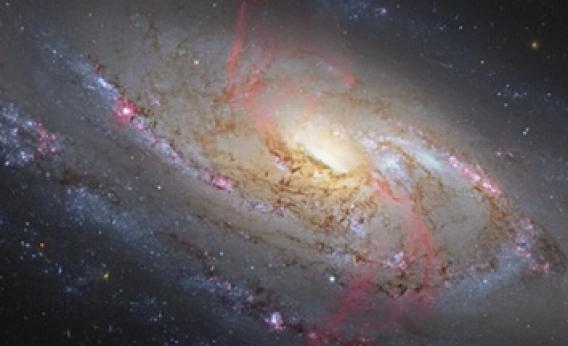Create a free profile to get unlimited access to exclusive videos, sweepstakes, and more!
Let Me Hold You in My Anomalous Arms

It’s been a while since I have slammed your brain with a huge and gorgeous spiral galaxy, so here’s the brain-slamming gorgeous and huge M106:
Oh my.
This mosaic was created by astrophotographer André van der Hoeven, using a combination of images from Hubble; the Canadian-French-Hawaii Telescope; the 1-meter telescope of the Tzec Maun Foundation in Cloudcroft, New Mexico; the Subaru telescope; and an RCOS 51-centimeter telescope. Van der Hoeven lists the details on his Flickr page for the image—and you can grab the ridiculously big 4,626 x 4,152 pixel version there, too.
I suggest you do take a look at that biggest version, because wow. The galaxy itself is incredible. I’ve written about it before—twice, actually. It’s a spiral about 25 million light-years away, more or less in our own neighborhood, and about the same size (or somewhat bigger) than our own Milky Way. At its core is a monster black hole 30 million times the mass of our Sun. It’s actively gobbling down matter, and, as it happens, black holes are messy eaters.
As the matter falls in it gets ferociously hot, and all that energy powers two beams of matter and energy that blast out from the black hole in opposite directions. Those beams slam into matter in the galaxy, heating it and causing it to glow: That’s why you see those weird red spiral arms that don’t align with the arms of the galaxy itself (which is why they’re called “anomalous arms”). That’s material that’s essentially being cooked by the energy from the black hole. If there are any planets orbiting stars there, I wouldn’t be too interested in investing in them for real estate. Lethal doses of X-rays tend to lower market resale value.
You don’t even have to look at M106 to be in awe of this pictures either; scan around the background and you’ll see hundreds of galaxies, far, far away—some are hundreds of millions or even billions of light-years distant.
I’m seeing more images like this all the time; a lot of astronomical data are public, and if you know what you’re doing you can combine them from vastly different telescopes to create amazing shots. But there’s science in here, and a lot of it! Astronomers can study specific parts of a galaxy, but putting them in context can reveal wonders as well. Objects in the galaxy that are too small to see in wide field images can sculpt structures on much larger scales, so putting them together can give us insight into events and connections that might otherwise be unnoticed.
Making the invisible visible is one of the things astronomy does best. And when it does, you can see beauty you didn’t even know existed.


























